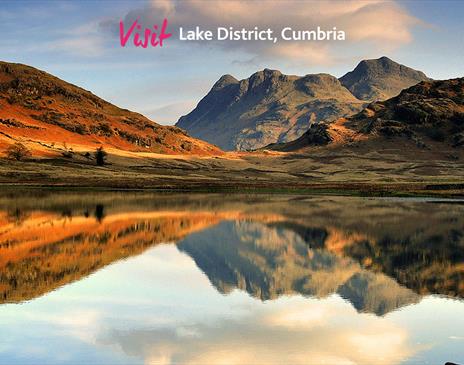- Accommodation
- What's On
- Things to Do
- Food and Drink
- Explore Cumbria
- Ideas and Inspiration
- Christmas & New Year
- Itineraries - Great days out
- Starring Great Britain: The Lake District, Cumbria
- Lake District, Cumbria Bucket List
- Selfie Guide
- Dark Skies Cumbria
- Cumbria Tourism Awards 2025
- The National Trust in the Lake District
- Sunny day ideas
- Rainy day ideas
- Romantic Breaks
- Family Holidays
- Dog Friendly Holidays
- Bespoke Holidays
- Caring for the environment
- Plan Your Visit
- Weddings
- Conferences & Event Spaces
- Prizes & Guides
- Let's Go Lake District Blog
- Special Offers
You are here: Home > Things to Do > History and Heritage > Cumbrian Churches
Church buildings are a perennial feature of the Cumbrian landscape. Usually they’re the oldest building in the parish, for it was around them that most of the earliest villages and towns were built. As a result, they are some of the most architecturally, culturally and historically significant buildings in an area.
These 'living' buildings, many of which still function as a place worship, are cultural and heritage landmarks. Many are fine examples of local and national craftmanship, and nearly all of them tell the story of Cumbria’s communities.
Cumbria has a history of invasion and settlement; the Romans, Celts, Anglo Saxons, Vikings, Normans and Border Rievers, all have lived and worshipped here and left their story in our church buildings; a fusion reflected in stone.
Characteristically small and simple, yet not without beauty and grace, they reflect the religious, social and economics of a rural landscape formed of lakes, mountains, coastline and border frontiers.
The Anglo-Scottish war (c1296 - c1513) curtailed the Decorated and Perpendicular styles, yet retained Norman influences as well as creating Cumbria's distinctive fortified churches. 18th century prosperity produced classical formality, Victorian growth and romanticism, contributed to the county known as the land of lakes and fells, Wordsworth, and Beatrix Potter.
The history of Cumbria and its people can be read in the stone of our churches, revealing the diversity of the county and the landscape in which they belong.
The Churches Trust for Cumbria exists to provide support to church buildings across Cumbria and aims to encourage the sustainable use of these unique heritage buildings and keep their communities alive. Delve further into the history of Cumbrian Churches by scrolling down to our list of churches around Cumbria lower down the page. For more information on a specific area of the county, use the links below. You can also find out more about individual churches within Cumbria on the 'A Church Near You' website.
Explore Cumbrian churches by area
Some of the most architecturally, culturally and historically significant buildings in Cumbria
- Accommodation
- Things to Do
- What's On
- Food & Drink
Number of results: 62
, currently showing 1 to 20.
Address
Church Walk, Ulverston, Cumbria, LA12 7ENUlverston
Step through a 12th century doorway into an oasis of calm where worship, history, wood and stones have tales to tell of the Mariners, merchants and a faithful community are celebrated in memorials and stained glass.
SEDBERGH
Brigflatts, near Sedbergh, Cumbria, is one of the most famous Quaker meeting houses, known and loved by Friends all over the world.
CARLISLE
The 8th century, Anglo Saxon Bewcastle Cross, stands free in the churchyard where it has been for nearly 1500 years. The church is somewhat simpler and certainly younger, with some parts of it dating from 1277, although mostly it is from the…
Address
Vicarage Lane, KIRKBY STEPHEN, Cumbria, CA17 4QXTelephone
01768 371279KIRKBY STEPHEN
Entered from the Market Square through handsome cloisters built in 1810, the parish church stands on the site of a Saxon church and contains many ancient relics.
Address
Muncaster, Ravenglass, Cumbria, CA18 1RJRavenglass
Located in the grounds of Muncaster Castle, it is believed that worship on this site dates to pre Christian times.
Built on land used by the monks of Furness Abbey to graze their sheep. It seems likely that there was an earlier church, in the…
Address
St Oswald’s church, Church Stile, Grasmere, Cumbria, LA22 9SWGrasmere
This church is well known because of its associations with the great Romantic poet William Wordsworth, who lived in nearby Dove Cottage and is buried in the churchyard.
Address
Banklands, WORKINGTON, Cumbria, CA14 3EPWORKINGTON
The church was designed by Edward Welby Pugin (son of Augustus Welby Pugin) and built between 1873 - 1876 to replace a chapel in the grounds which now forms part of St Joseph's High School.
Address
St. Bega's Church, Keswick, Cumbria, CA12 4QZKeswick
The church, dedicated to the Celtic Saint Bega, is situated in a picture perfect setting in fields on the east shore of Bassenthwaite Lake.
Address
Main Street, BRAMPTON, Cumbria, CA8 1SHTelephone
01697 741304BRAMPTON
A 'very remarkable building with windows glowing with gemstone colours', according to architectural historian Nikolaus Pevsner and the only church designed by preRaphaelite architect Philip Webb.
Address
Vicarage Road, AMBLESIDE, Cumbria, LA22 9DHTelephone
015394 34512AMBLESIDE
Visible from miles around that spire of St Mary’s nestles into the beautiful landscape of the Heart of the English Lake District.
Address
Aldingham, Ulverston, Cumbria, LA12 9RTUlverston
Aldingham church hugs the Cumbrian side of Morecambe Bay and is open to the wild beauty of the Bay, an area of designated county landscape importance and scenic beauty.
Address
Dean, Workington, Cumbria, CA14 4THWorkington
In spite of the eclectic origins of its many parts, St Oswald's significance lies it its alterations and accumulation of features over time including Norman font and walls, 13th century windows, 15th century chancel and furniture by Thompson (the…
Address
Wasdale Road, Gosforth, SEASCALE, Cumbria, CA20 1AUSEASCALE
St Mary's has been an important religious site since the 8th century.
Address
The Glebe, Abbeytown, WIGTON, Cumbria, CA7 4SDWIGTON
Caught in the Anglo Scottish wars of the 14th century, a good bit of luck followed the Dissolution of the Monasteries for this church, when the local people successfully petitioned Thomas Cromwell to allow them to continue to use the church.
Address
Dacre, PENRITH, Cumbria, CA11 0HLPENRITH
A beautiful Norman church on site of 7th century monastery in peaceful Lakeland location and home of the Dacre Bears, four unique medieval stone statues.
Address
High Street, WHITEHAVEN, Cumbria, CA28 7PYWHITEHAVEN
A fine example of a Georgian church, which has been sympathetically modernised.
Address
The Square, Hawkshead, Ambleside, Cumbria, LA22 0NZAmbleside
One of the oldest Methodist Churches in the world and possibly one of the most unique buildings.
Converted from a 15th century cottage in 1862, a small group of local Christians worshipped at 'Union Chapel'. The benefactor was Mrs Satterthwaite. In…
Address
Beetham, Milnthorpe, Cumbria, LA7 7ALMilnthorpe
The beautiful Grade I church we see today, situated by the River Bela, is the result of additions and adaptations through the centuries.
Mass dials, masons marks, medieval stained glass, a fine Forster & Andrews organ, tower bells and gravestones…Address
Isel, Cockermouth, Cumbria, CA13 9SRCockermouth
Isel church is a beautiful Grade I listed building, which is located in an idyllic position in a carefully tended churchyard close to the River Derwent and the grounds of Isel Hall.
Address
Wasdale Head, SEASCALE, Cumbria, CA20 1EXSEASCALE
The smallest church near the deepest lake and the highest mountain in England.
You may also like
Receive all the latest news, special offers and information from the Lake District, Cumbria
Cumbria Tourism, Windermere Road, Staveley, Kendal, Cumbria, LA8 9PL



 to add an item to your Itinerary basket.
to add an item to your Itinerary basket.







